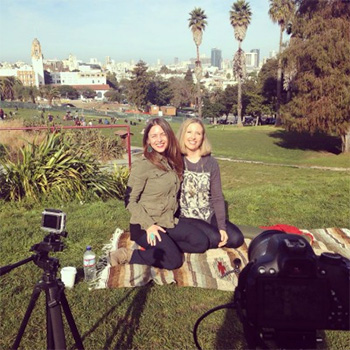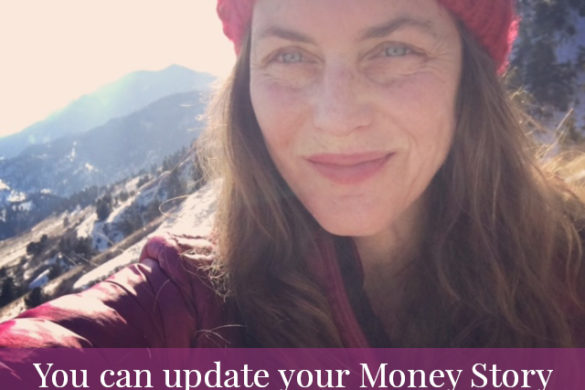Dear Community,
Today, I am blessed and so excited to have my friend Karin Robbins bring you much deeper into the somatic world. She is a Somatic Experiencing Therapist and one of the beloved T.A’s (Transformation Assistants) in our year-long Art of Money money school. She has done her own Art of Money work for a few years now, living and breathing the connection between somatic work and money work. She is also a wonderful therapist, space-holder, and keeper of simple somatic tools and practices.
I interviewed Karin for our recent Art of Money Roadshow, for member’s only interviews inside of the Art of Money program, and now she’s here sharing her first guest blog post with you.
May you enjoy her deep wisdom...

5 simple somatic tools you can use today that will change your money life.
Guest Post by Karin Robbins.
I am so happy to be writing to you today about Somatic Practice and Money. I have been immersed in somatic work, personally and professionally, since 2009, and have been using a combination of these practices and Bari’s Art of Money method since 2013. My personal journey with money continues to be a practice, a relationship, and somatic work is at the very foundation of it all. I’m so honored and excited to share a piece with you!
So, what does “somatic” mean?
Simply, it means “body.”
We are bringing the body into our conversation, and relationship, with money through these somatic practices.
Why would we want to do that?
1. Somatic practice supports presence, which is a prerequisite for being in relationship with anything. Embodied awareness, or presence, helps us engage with money and life in a soulful, connected way.
2. It helps us feel safe. Safety is a doorway that allows us to enter more deeply into relationship in all areas of our lives, including our relationship with money. Without this safety in our money relationship, we may feel stressed, overwhelmed, stuck, or shut down. Not the most accessible states for connection and engagement, right? Of course not. And, there is reason for that.
When we think we are in danger, we can’t easily access the parts of ourselves that allow for ease of connection and relationship. When we are in danger our bodies start to react to that stress and we want to protect ourselves. Many of these body level self-protective responses – such as fight, flight, and freeze – are normal and natural states when we are truly in danger. They are very helpful. Except when we are stuck in them much of the time. They are not meant to be relied upon for everyday experiences like paying bills and reconciling bank accounts.
Believe me, I know that these experiences can feel like danger sometimes, and that is exactly why we want to support our bodies in establishing more safety. So that we can be in healthy relationship and not live in overwhelm.
3. These practices help us to be with the full spectrum of our emotions. Learning to be with difficult emotions, such as fear, sadness, grief, and anger, also empowers us to be with pleasurable emotions, such as joy and love, and pleasurable states like abundance and peace. All of these can be held with loving awareness when we have more somatic capacity.
4. Somatic practice helps us with new ways of being, new behaviors, to support us in holding this full spectrum of experience. New behaviors can replace what may not be working so well, such as shutting down, putting our head in the sand, panic, and avoidance. (I’ll get to these new behaviors, somatic tools, in just a moment.)
In my work as a Somatic Psychotherapist and Coach, I am steeped in this work every day. And, I live and breathe this work in all areas of my life. It is a way of being for me. My sacred practice for increased connection and vitality.
There are so many different ways of supporting ourselves somatically, many possible steps along our paths. We are going to explore just one step today. One important step. One step into understanding ourselves, our money, and our relationship from a somatic perspective. A step that I consider the heart of somatic practice.
Self-Regulation.
I’m actually going to start by telling you what self-regulation is NOT, because I know that there are people who constrict immediately when they hear the words “self-regulation.” They imagine that I am talking about confinement or restriction or watering down emotions, “regulating” themselves in some unpleasant and boring way, making themselves smaller. This is exactly what self-regulation is NOT. It’s NOT about making ourselves smaller, confining ourselves, or washing away our emotional experience.
Additionally, if we are already feeling a lot of different emotions, light or intense, and we are able to be with them, there is a natural self-regulation. In that case, we don’t actually need to do anything. It’s happening. We need to practice self-regulation when we are feeling overwhelmed, panicked, or shut down.
So, what IS self-regulation?
Self-regulation is the ability to slow down enough to connect with our inner experience, to notice when we may be feeling overwhelmed, or panicked, or ready to shut down, actively engaging with somatic tools, and noticing when we have returned to a more easeful state. It is a practice that we do for ourselves, with ourselves, that allows us to build capacity to be with more and more of our experience.
And, it is an AMAZING tool to bring into our money work that allows us to establish, and maintain, and grow our relationship with money. So, we are not just talking about supporting an easier time with really overwhelming emotions, we are also supporting an easier time with joy and abundance and love.
Sound good?
Okay, great! Here are a few of my favorite somatic tools that support self-regulation. Each one is supported by bringing in loving awareness and curiosity.
Slowing Down
The first tool is slowing down, which we can actually practice right now.
I invite you to take a pause right here. See what you are noticing in your body. Take a few breaths.
Connect with your heart.
As you read on, see what may resonate with you and start there.
Grounding
The second tool is called grounding, which really means just what it sounds like … we connect with the ground. More specifically, we use our relationship with gravity and the earth as a practice for settling and stabilizing ourselves.
We can practice a simple grounding exercise by taking a moment to feel the connection between our bodies and the earth. A few ways to do that include: feeling your feet in contact with the ground … your seat and back in contact with the chair … your hands in contact with the desk. See if you notice your body resting any more deeply into the floor, or the chair, or the desk as you feel the contact.
Feel free to move your body for grounding. For many of us, it’s excruciating to sit still – so, by all means, please move! For grounding movement, remember to slow down and feel your connection with the earth through your feet or your hands or any other part of the body that is in contact with the ground. The idea here isn’t to learn rote exercises, but to explore what helps us feel more present. I really enjoy practicing gentle grounded movement through dance and yoga.
Nature and textures are great for grounding too! I love to hold rocks in my hands, touch trees (yes, I hug them), and sit on the ground. Sitting on the ground with my spine in contact with a tree, feeling the earth and the roots and the solid trunk is an absolute favorite of mine. I highly recommend giving that one a try. I live in Los Angeles, so I also imagine trees and my connection with them if I can’t get out into nature right away. This works too.
Everyone is different. I encourage you to explore which of these may help you feel more connected with the earth, with the ground, and spend some time with those.
Resourcing
The third somatic tool is called resourcing. This is a beautiful self care exercise that supports settling, safety, trust and ease. We can practice resourcing by connecting with our experience, either internally, in the body or through images (like I mentioned above, imagining the trees), or externally, in our environment.
Let me explain.
We can use pleasant places in our bodies as resources, by allowing ourselves to get curious about where we may feel pleasant or neutral sensations, and keeping our attention there. Let’s take a moment to practice. Make sure you are as comfortable as possible. Then begin to notice what sensations are present, what emotions may emerge. Slow down, allow yourself to be with the pleasant, or even neutral, sensations and emotions. Notice what happens in your body. And, if you aren’t feeling anything pleasant, not to worry, everyone is different and things are changing all the time.
So, now let’s talk about images. Images are another great tool that we have access to any time. Imagine yourself in a place that you love, maybe near the ocean, or in the mountains, near a river, sitting on a rock, or surrounded by trees (can you tell I love my nature resources?). Then, as you remember this place with all of your senses … what do you see? what do you hear? what does it smell like? what can you touch? what do you taste? … take a moment and check in with your body. Do you notice any settling? Any more ease? Take your time. You can also do this by imagining other kinds of resources. For example, people, pets, beloved mentors, etc. What is a resource for you?
Our external environment can also be a valuable resource. Bari is always talking about this. Essential oil spritzers, chocolate, candles, mochas … these are all beautiful resources that she brings into her life and money work. Bari is creating an environment for herself that supports safety and settling. In so doing, she is allowing her heart to open, and connect, and become more available for whatever she needs to do that day. This is resourcing!
Titration
The last tool that I would like to share today is called titration. Titration means taking in little bit of experience at a time, slowing down, and allowing any “overwhelm” (anything that starts to feel like “too much”) to settle before moving on to another piece of experience.
It’s so important for our ability to self regulate to take the time we need to integrate chunks of experience. Good stuff and hard stuff, it all needs time to integrate. Here are some ideas to titrate our money work.
Choose to work with just one piece of your money story, rather than diving into the whole story. Start with one image or piece of a story. Check in with your body, try some grounding and resourcing, and see what you experience with that one memory. Notice if there is any “overwhelm” and, if so, allow that to settle before moving on to another image or piece of the story. Maybe you want to write in a journal or share your experience with someone before moving on to the next piece. This can be a wonderful titration too.
When sitting down to do money practices, like paying the bills or reconciling accounts, take one step at a time and check in with your body between each step, allow any “overwhelm” to settle, then take the next step. For example, log in to your account. Pause. Allow yourself to settle. Then, look at the numbers. Pause. Allow yourself to settle. Then choose the first bill to pay. Pause. Allow yourself to settle. I know this may seem like it will take eons to pay your bills. It does take some practice and not everyone settles completely. Even allowing a slight settling before going on to the next step will be supportive for you.
Need to talk with your partner about money? Maybe there is a history of arguing or flooding or avoiding money in your relationship? One way to titrate this is to talk about putting a date on the calendar, and let that settle. How is it just to get a date on the calendar to talk about your relationship with money? What is the next step that is needed? Perhaps you want to plan one topic for your money date. Maybe it’s a date to look at numbers and that is all. Look and connect with money and with each other. I encourage each of you take time to settle before you share or make a plan for the next step.
You can make the titrations as small as you need to support your ability to self regulate. Can you imagine other ways that you may use titration in your daily life? I encourage you to explore those as well.
 You may have already noticed, as we have been exploring these tools, that they all go together. For example, we can use grounding and resourcing to support us in titrating our experience. And, we are always slowing down so that we can lovingly be in connection with ourselves and our experience.
You may have already noticed, as we have been exploring these tools, that they all go together. For example, we can use grounding and resourcing to support us in titrating our experience. And, we are always slowing down so that we can lovingly be in connection with ourselves and our experience.
Bari’s work is near and dear to my heart. I am so happy to begin sharing these somatic practices and tools with this wonderful community.
Can you imagine bringing just one of these tools into your relationship with money? And your life? That is my invitation to you.
Take your time.
Enjoy yourself.
 Karin Robbins is a Licensed Clinical Social Worker and Somatic Experiencing (SE) Practitioner, also certified in SE Touch Skills for Trauma. Karin's work focuses on present moment, body based, psychotherapies for healing trauma, attachment and relational difficulties. Karin has extensive experience practicing mindfulness meditation and is a certified Yoga and Ayurveda Specialist (300 hours). Karin has a newfound love of embodied feminine wisdom traditions, and is currently studying through dance! Karin's work is informed by all of these healing approaches, from both the East and the West. Additionally, Karin spent twenty two years working in public and private agency settings, providing direct services, individual, and group supervision, prior to becoming a full time entrepreneur. www.karinrobbbinslcsw.com
Karin Robbins is a Licensed Clinical Social Worker and Somatic Experiencing (SE) Practitioner, also certified in SE Touch Skills for Trauma. Karin's work focuses on present moment, body based, psychotherapies for healing trauma, attachment and relational difficulties. Karin has extensive experience practicing mindfulness meditation and is a certified Yoga and Ayurveda Specialist (300 hours). Karin has a newfound love of embodied feminine wisdom traditions, and is currently studying through dance! Karin's work is informed by all of these healing approaches, from both the East and the West. Additionally, Karin spent twenty two years working in public and private agency settings, providing direct services, individual, and group supervision, prior to becoming a full time entrepreneur. www.karinrobbbinslcsw.com
** These tools and concepts come from my training in Somatic Experiencing® (SE), a natural approach to healing trauma developed by Dr. Peter Levine. For more information on SE, please visit Somatic Experiencing Trauma Institute, www.traumahealing.org.





